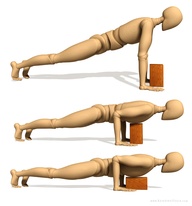 My latest post on MindBodyGreen: 7 Reasons to Modify Your Yoga Practice With Props
My latest post on MindBodyGreen: 7 Reasons to Modify Your Yoga Practice With Props
Some of the yoga classes I attended 20 years ago were very minimalist in terms of yoga props. The yoga mat industry was much younger as well, and the choices of mats was limited to thin and thicker. At the studio where I taught we did have straps and cylindrical bolsters, but they felt hard to use, and didn’t really improve my practice or lend too much therapeutic tone to the class. In fact, some teachers felt that using props was both forceful and made it seem like the yoga equivalent of cheating at Scrabble.
Fast forward to an era where there are different kinds of mats, from eco friendly to exra absorbant. Yoga walls are popping up and the prop business has really taken off at the speed of OM. So why is it that some people scrunch up their faces and turn a cold upper trapezius when they hear the phrase “modify the practice to suit your needs?”
This is actually the key to understanding yoga therapy, as we teach that yoga isn’t a “one-size-fits-all” practice even though it’s accessible to everyone. I believe finding your modifications instead of tying yourself up in knots trying on poses the way everyone else is doing them is both positive and empowering.
Using a strategically placed prop can open your body, increasing range of motion, flexibility, and strength. Sometimes one muscle group becomes dominant because it overworks, which leaves other areas weak and underdeveloped. Using support doesn’t mean collapsing into it. On the contrary, using the prop as feedback provides valuable information, especially about what your unique yoga needs are.
Here are seven reasons to turn your physical practice of YOGA into YOGAtherapy. A well-placed prop can:
1. Help you learn the skill involved in sustaining alignment.
Have fun with it!




